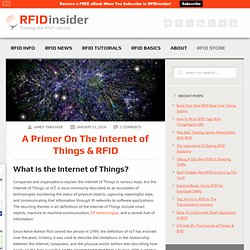

Internet of Things. The Internet of Things (IoT) is the network of physical objects or "things" embedded with electronics, software, sensors and connectivity to enable it to achieve greater value and service by exchanging data with the manufacturer, operator and/or other connected devices.

Each thing is uniquely identifiable through its embedded computing system but is able to interoperate within the existing Internet infrastructure. The term “Internet of Things” was first documented by a British visionary, Kevin Ashton, in 1999.[1] Typically, IoT is expected to offer advanced connectivity of devices, systems, and services that goes beyond machine-to-machine communications (M2M) and covers a variety of protocols, domains, and applications.[2] The interconnection of these embedded devices (including smart objects), is expected to usher in automation in nearly all fields, while also enabling advanced applications like a Smart Grid.[3]
The Internet of Things. A Primer on the Internet of Things and RFID. What is the Internet of Things?

Companies and organizations explain the Internet of Things in various ways, but the Internet of Things, or IoT, is most commonly described as an ecosystem of technologies monitoring the status of physical objects, capturing meaningful data, and communicating that information through IP networks to software applications. The recurring themes in all definitions of the Internet of Things include smart objects, machine to machine communication, RF technologies, and a central hub of information.